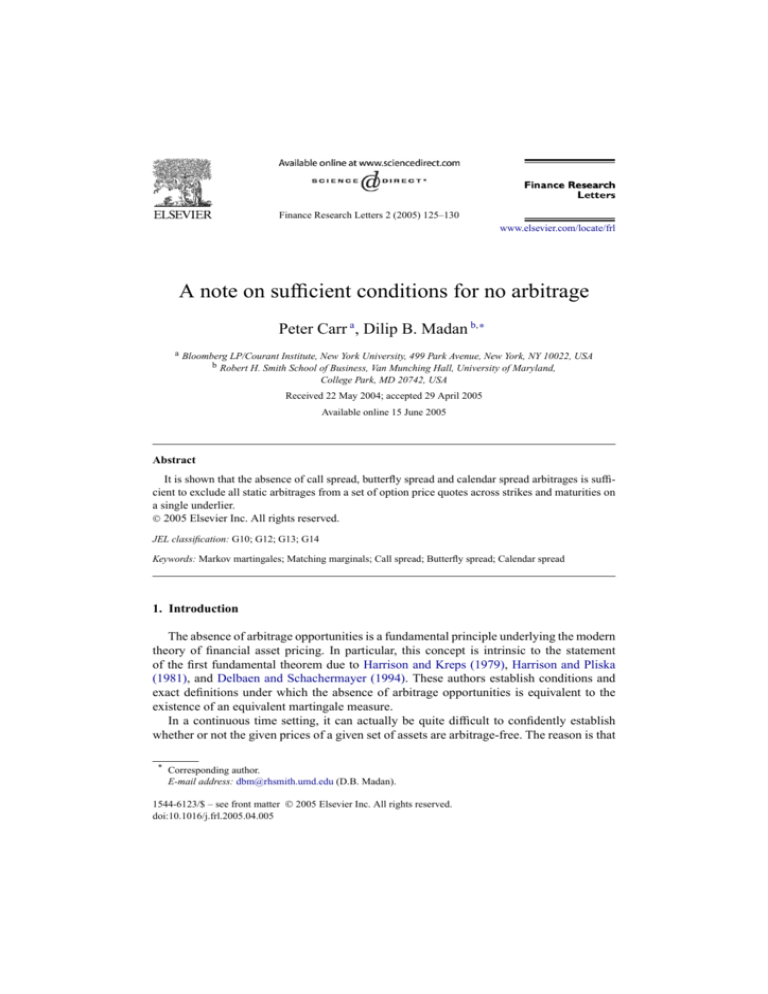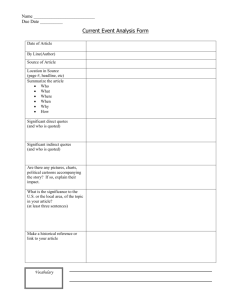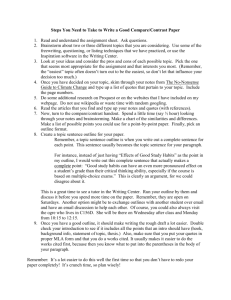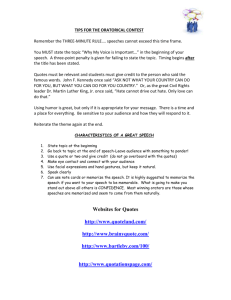
Finance Research Letters 2 (2005) 125–130
www.elsevier.com/locate/frl
A note on sufficient conditions for no arbitrage
Peter Carr a , Dilip B. Madan b,∗
a Bloomberg LP/Courant Institute, New York University, 499 Park Avenue, New York, NY 10022, USA
b Robert H. Smith School of Business, Van Munching Hall, University of Maryland,
College Park, MD 20742, USA
Received 22 May 2004; accepted 29 April 2005
Available online 15 June 2005
Abstract
It is shown that the absence of call spread, butterfly spread and calendar spread arbitrages is sufficient to exclude all static arbitrages from a set of option price quotes across strikes and maturities on
a single underlier.
2005 Elsevier Inc. All rights reserved.
JEL classification: G10; G12; G13; G14
Keywords: Markov martingales; Matching marginals; Call spread; Butterfly spread; Calendar spread
1. Introduction
The absence of arbitrage opportunities is a fundamental principle underlying the modern
theory of financial asset pricing. In particular, this concept is intrinsic to the statement
of the first fundamental theorem due to Harrison and Kreps (1979), Harrison and Pliska
(1981), and Delbaen and Schachermayer (1994). These authors establish conditions and
exact definitions under which the absence of arbitrage opportunities is equivalent to the
existence of an equivalent martingale measure.
In a continuous time setting, it can actually be quite difficult to confidently establish
whether or not the given prices of a given set of assets are arbitrage-free. The reason is that
* Corresponding author.
E-mail address: dbm@rhsmith.umd.edu (D.B. Madan).
1544-6123/$ – see front matter 2005 Elsevier Inc. All rights reserved.
doi:10.1016/j.frl.2005.04.005
126
P. Carr, D.P. Madan / Finance Research Letters 2 (2005) 125–130
the definition of an arbitrage opportunity depends critically on the nature of the information
set which can be used in developing trading strategies in the specified assets. Likewise, the
associated continuous time martingales are defined through conditional expectations which
rely on the same informational basis. Typically, this informational basis includes the entire
path of past underlying asset prices at a minimum. Hence, to certify that a given set of
asset prices are arbitrage-free in continuous time, the structure of the possible price paths
must be specified a priori. For example, one must specify whether the possible price paths
are purely continuous, pure jump, or a combination of the two. One must also specify
whether the possible price paths display finite or infinite variation over time. Since one
can only observe past prices in practice and then only discretely, it is difficult to have any
confidence in any particular structure which is imposed on future paths. Nonetheless, a
certification that a given set of asset prices is arbitrage-free in the traditional sense does
require this specification of the nature of the possible price paths.
One way out of this difficulty is to alter the technical definition of an arbitrage opportunity. By reducing the size of the information set upon which trading strategies can rely, it
becomes easier to certify that a given set of asset prices are free of these restricted arbitrage
opportunities. A concrete example of such a restricted set of trading strategies is given in
Carr, Géman, Madan and Yor (2003) (henceforth CGMY). These authors introduce the
phrase “static arbitrage” to describe a much simpler concept of an arbitrage opportunity.
Parsing this phrase, the arbitrage part refers as usual to a costless trading strategy which at
some future time provides a positive profit with positive probability, but has no possibility
of a loss. The static part of the phrase signifies that the position taken in the underlying
stock at a particular time can only depend on the time and on the contemporaneous stock
price. Positions cannot depend on past prices or their path properties. CGMY establish
the equivalence of no static arbitrage with the existence of a Markov martingale in some
information filtration. This martingale is used to price the assets just at the initial time
by discounting the expected cash flow under this process. Assuming that the initial market
prices of a given set of European calls are free of static arbitrage, Madan and Yor (2002) go
beyond the CGMY existence result by providing several concrete constructions of Markov
martingales which are consistent with these prices.
The CGMY results suggest a related problem which is of considerable practical interest.
This problem is to determine whether or not a given rectangular grid of European option
prices quoted across several strikes and maturities is in fact free of static arbitrage. Many
specific arbitrages are known due to the seminal results of Merton (1973) and others, but it
is still unclear at this relatively late date whether the elimination of these known arbitrages
is sufficient to exclude all static arbitrages. The limited but useful contribution of this short
note is to establish the structure of a finite set of tests that do in fact imply that all of the
option quotes are free of static arbitrage. If the given option quotes pass our set of tests,
then no further tests need to be conducted in order to certify that the quotes are free of
static arbitrage.
A critical step in the formation of our tests requires the extraction of risk-neutral probability measures at each maturity from quoted option prices. This fundamental idea is
essentially due to Breeden and Litzenberger (1978). The extraction of these measures is
followed by establishing sufficient conditions for these measures to be increasing in the
convex order as described in Shaked and Shantikumar (1994). We next appeal to Kellerer
P. Carr, D.P. Madan / Finance Research Letters 2 (2005) 125–130
127
(1972) who establishes that these conditions are equivalent to the existence of a Markov
martingale with the same marginals as those extracted from option prices. The filtration
for this martingale includes price paths and hence the current price. Standard results then
imply that there are no static arbitrage opportunities. We note that Kellerer’s results are
also implicit in the earlier works in economics on increasing risk published in Rothschild
and Stiglitz (1970, 1971).
The structure of this note is as follows. Section 2 establishes sufficient conditions for the
existence of a risk-neutral probability measure at each maturity. Section 3 lists sufficient
conditions for these measures to be increasing in the convex order. Section 3 also shows
that our set of tests are jointly sufficient to establish that the provided option quotes are
free of static arbitrage. Section 4 concludes.
2. The price grid and marginal probabilities
We suppose that at some fixed time, we have been given several market quotes for
European call options arranged on a rectangular grid. More specifically, the quotes are for
a countably infinite collection of discrete strikes and for each strike, the quotes are for
a common set of maturities which are finite in number. We recognize that the assumed
regularity of the provided data may fail to hold in practice, but we regard the issue of
missing data as an alternative problem.
Let Cij denote the given quote for a call of strike Ki , i = 1, . . . , ∞, and maturity Tj ,
j = 1, . . . , M. We suppose that the strikes Ki form an increasing and positive sequence
as do the maturities Tj . We also suppose that the strikes tend to infinity as i tends to
infinity. We require that the given call prices tend to zero as the strike becomes infinite.
Furthermore, we suppose that interest rates and dividends are zero over the period ending
at the longest maturity. We augment the provided call quotes with quotes for calls of strikes
K0 ≡ 0. For each maturity, these additional quotes are taken to be S0 , the current spot price.
We also take the prices at maturity T0 = 0 to be (S0 − Ki )+ , i = 1, . . . , ∞. This gives us
the augmented matrix of prices Cij , with now i = 0, . . . , ∞ and j = 0, . . . , M.
Suppose that for each j > 0, we define the following quantities:
Qi,j ≡
Ci−1,j − Ci,j
,
Ki − Ki−1
i > 0,
Q0,j ≡ 1.
(1)
For each i > 0, Qi,j is clearly the cost of a vertical spread which by definition is long
1/(Ki − Ki−1 ) calls of strike Ki−1 and short 1/(Ki − Ki−1 ) calls of strike Ki . A graph
of the payoff from this position against the terminal stock price indicates that this payoff
is bounded below by zero and above by one. We therefore require for our first test that
Qi,j ∈ [0, 1] for all i, j .
Next, for each j > 0, we define the following quantities:
BSi,j ≡ Ci−1,j −
Ki+1 − Ki−1
Ki − Ki−1
Ci,j +
Ci+1,j ,
Ki+1 − Ki
Ki+1 − Ki
i > 0.
For each i > 0, BSi,j is clearly the cost of a butterfly spread which by definition is long
the call struck at Ki−1 , short (Ki+1 − Ki−1 )/(Ki+1 − Ki ) calls struck at Ki , and long
128
P. Carr, D.P. Madan / Finance Research Letters 2 (2005) 125–130
(Ki − Ki−1 )/(Ki+1 − Ki ) calls struck at Ki+1 . A graph quickly indicates that the butterfly
spread payoff is nonnegative and hence our second test requires that
Ci−1,j −
Ki+1 − Ki−1
Ki − Ki−1
Ci,j +
Ci+1,j 0.
Ki+1 − Ki
Ki+1 − Ki
Equivalently, we require that
Ci−1,j − Ci,j Ki − Ki−1
(Ci,j − Ci+1,j ).
Ki+1 − Ki
(2)
It follows from (1) and (2) that the risk-neutral complementary distribution functions are
declining at each maturity:
Qi,j Qi+1,j ,
i, j 0.
Given that the call quotes pass both tests, suppose we now define
qi,j ≡ Qi,j − Qi+1,j =
Ci−1,j − Ci,j
Ci,j − Ci+1,j
−
,
Ki − Ki−1
Ki+1 − Ki
i = 1, . . . , ∞.
(3)
The sequence of nonnegative
numbers qi , i = 1, . . . , ∞, defines a probability mass func
tion (PMF) since ∞
q
=
1. We may interpret each qi,j as the marginal risk-neutral
i,j
i=1
probability that the stock price at maturity Tj equals Ki for i = 1, . . . , ∞. Furthermore, (3)
implies that the risk-neutral complementary distribution function can be recovered from the
risk-neutral PMF by
Qi,j =
∞
qk,j ,
i, j > 0.
k=i
Summarizing to this point, we have imposed two tests on the provided call quotes.
Assuming that the quotes pass both tests, the quotes have been manipulated in a standard
way to yield the marginal risk-neutral probabilities of the stock price being at level Ki at
time Tj for all i, j 0. We may now define the call pricing function on the continuum of
strikes K 0 for each discrete maturity Tj by
Cj (K) ≡
(Kl − K)+ ql,j .
l
The call prices obtained in this way linearly interpolate the provided call quotes. For future
use, we also associate with each maturity a risk-neutral probability measure defined by
Qj (K) =
ql,j .
Kl K
As K increases from 0, this measure will be piecewise constant and increasing from 0 to 1.
P. Carr, D.P. Madan / Finance Research Letters 2 (2005) 125–130
129
3. The convex order
As a third and final test on the provided call quotes, we require that for each discrete
strike Ki , i 0, and each discrete maturity Tj , j 0:
Ci,j +1 − Ci,j 0,
i, j 0.
(4)
The left-hand side of (4) is clearly the cost of a calendar spread consisting of long one call
of maturity Tj +1 and short one call of maturity Tj , with both calls struck at Ki . Hence,
our third test requires that calendar spreads comprised of adjacent maturity calls are not
negatively priced at each maturity.
As the call pricing functions are linear interpolations of the provided quotes, we have
that at each maturity Tj , calendar spreads are not negatively priced for the continuum of
strikes K > 0. Since all convex payoffs may be represented as portfolios of calls with
nonnegative weights, it follows that all convex functions φ(S) are priced higher when
promised at Tj +1 than when they are promised at Tj . In turn, this ordering implies that the
risk-neutral probability measures Qj (K) constructed in the last section are increasing in
the convex order with respect to the index j .
By the results of Kellerer (1972), it follows that there exists a discrete time Markov
martingale Mj with
E[Mj +1 | Mj ] = Mj ,
such that all of the call prices satisfy
Cj (K) = E (Mj − K)+ ,
K > 0, j = 0, 1, . . . , m.
This further implies that there exists a martingale measure which is consistent with the call
quotes and which is defined on some filtration that includes at least the stock price and
time. Finally, it follows that the provided call quotes are free of static arbitrage by standard
results in arbitrage pricing theory.
4. Conclusion
This short note has shown that a rectangular grid of European call quotes are free of
static arbitrage if all adjacent vertical spreads, butterfly spreads, and calendar spreads are
nonnegatively priced. The result relies on deep results on constructing Markov martingales
which match given marginals when the latter are found to be increasing in the convex order.
These results go back to the work of Rothschild and Stiglitz (1970, 1971) in economics and
Kellerer (1972) in probability theory. Although both of these works are widely cited in their
respective fields, their relevance for option pricing has not been previously highlighted
to our knowledge. The current note rectifies this oversight by drawing attention to these
papers and linking them to other well-known results in the option pricing literature.
130
P. Carr, D.P. Madan / Finance Research Letters 2 (2005) 125–130
References
Breeden, D., Litzenberger, R., 1978. Prices of state contingent claims implicit in option prices. Journal of Business 51, 621–651.
Carr, P., Géman, H., Madan, D.B., Yor, M., 2003. Stochastic volatility for Lévy processes. Mathematical Finance 13, 345–382.
Delbaen, F., Schachermayer, W., 1994. A general version of the fundamental theorem of asset pricing. Mathematische Annalen 300, 463–520.
Harrison, J., Kreps, D., 1979. Martingales and arbitrage in multiperiod securities markets. Journal of Economic
Theory 20, 381–408.
Harrison, M., Pliska, S., 1981. Martingales and stochastic integrals in the theory of continuous trading. Stochastic
Processes and Their Applications 11, 215–260.
Kellerer, H.G., 1972. Markov-Komposition und eine Anwendung auf Martingale. Mathematische Annalen 198,
99–122.
Madan, D.B., Yor, M., 2002. Making Markov martingales meet marginals. Bernoulli 8, 509–536.
Merton, R.C., 1973. Theory of rational option pricing. Bell Journal of Economics and Management Science 4,
141–183.
Rothschild, M., Stiglitz, J.E., 1970. Increasing risk: I. A definition. Journal of Economic Theory 2, 225–243.
Rothschild, M., Stiglitz, J.E., 1971. Increasing risk: II. Its economic consequences. Journal of Economic Theory 3,
66–84.
Shaked, M., Shantikumar, J.G., 1994. Stochastic Orders and Their Applications. Academic Press, San Diego.








